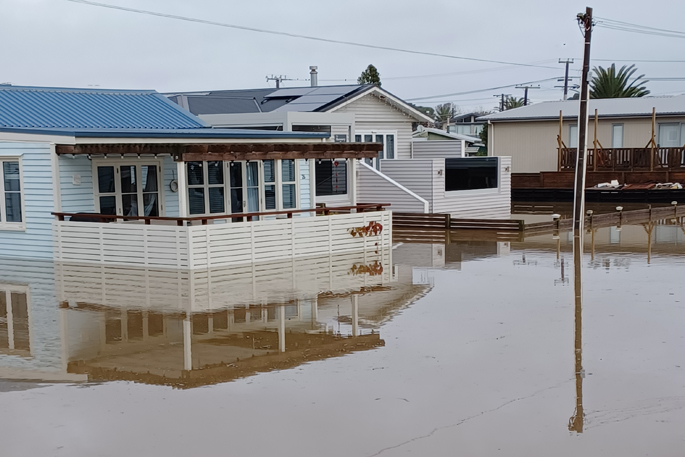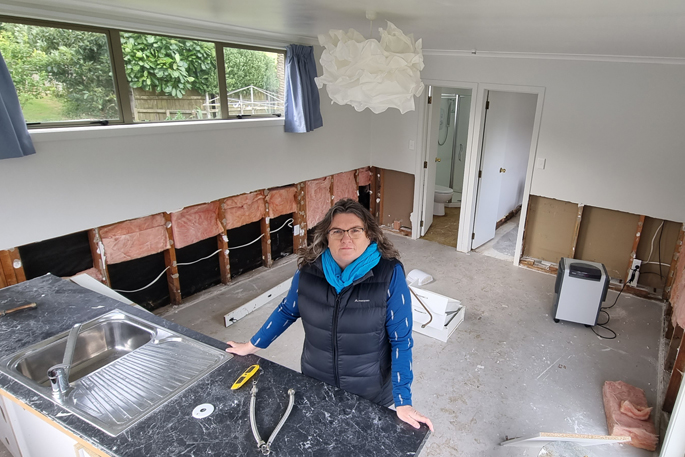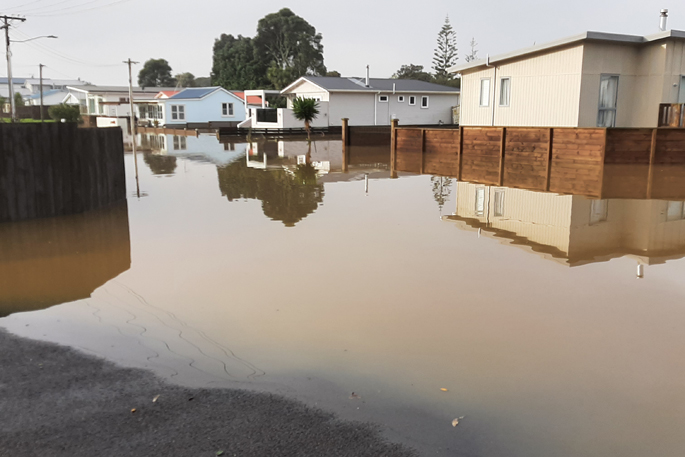“The most violent of weather” pummelled the coastal community of Waihī Beach on May 29 causing flash flooding and the town’s dam to overflow.
Water rushed through the northern end of the Western Bay of Plenty town filling up creeks and flowing over roads.
Heather Cumming was one of 27 people forced to evacuate her home that day, alongside 11 elderly residents from the nearby pensioner housing and two families from the holiday park.
“It was that most violent of weather. You’ve got your rain, your lightning, and your thunder. And I thought, wow, this is it,” Cumming’s voice shakes as she recalls the event.
Another local, Sue Hope says the May 29 flood was “history repeating itself” after a similar thing happened in 2012.
Could it have been avoided? Some residents believe it could have.
The second of this two part series by Local Democracy Reporter Alisha Evans will delve into this.
The Western Bay of Plenty District Council recorded 67mm of rain between 1pm and 2.30pm and a total of 91.4mm on May 29.
The town’s dam overflowed into the emergency spillway for 40 minutes from 1.26pm.
The council admits the stormwater network didn’t have the capacity to deal with the amount of rain that fell that day.
A 2017 Tonkin & Taylor report ‘Waihi Beach Stormwater Model’ commissioned by the council showed a number of pipes in the network were “under capacity” for 2, 5 and 10 year average recurrence interval (ARI). ARI is the average time period between floods of a certain size.
It also says a number of pipes were full from being surcharged by backwater from the sea or stormwater ponding.
“Flooding caused by backwater surcharged pipes is not able to be mitigated without making significant changes to rest of the connected stormwater network,” the report says.
 The water reached 1.2m high at Heather Cumming's house on May 29. Photo: Supplied.
The water reached 1.2m high at Heather Cumming's house on May 29. Photo: Supplied.
Cumming’s home on Marine Avenue is one of those in the low lying area more prone to flooding.
She was “stunned” when she was told she needed to evacuate by the fire service. She got some neighbours to take her elderly dog, Sparky, and tried to “pick up a few things up off the floor”.
The 61-year-old waded through chest high water, contaminated with sewage that reached 1.2m. It flooded the raised sleep out, turned Airbnb, at the back of her property and came into the main house.
“I walked out and I was soaking wet, absolutely freezing, so I got the dog and drove to mum's in Pyes Pā.”
The days that followed were a blur of friends and family pitching in and helping to replace floorboards, remove sodden underfloor insulation, cut out wet gib board and clean the silt and debris that permeated every crevice of Cumming’s home.
“For the first couple of days, I couldn't actually speak. It's very confronting when everything you own is on the front lawn because it's not worth anything.”
Cumming was uninsured for flooding because her home was affected by the 2012 floods, around 1cm of water came into the rear of the main house.
She says her husband was looking forward to cutting back at work but now they can’t do that because of the repair bill and they may look at raising their home.
 Everything in Heather Cumming’s newly renovated Airbnb was damaged by flood water. Photo: Alisha Evans/SunLive.
Everything in Heather Cumming’s newly renovated Airbnb was damaged by flood water. Photo: Alisha Evans/SunLive.
The council recommended properties in the low lying areas raised their homes and would waive the consent processing fees for at risk properties.
Cumming echoes a lot of the community’s sentiment in saying: “Thank goodness it happened in the daytime and not night, because the old people’s [flats], someone might've died over there.”
Waihī Beach Community Board chair Ross Goudie agrees: “They'd have been asleep and the water would've been up around their beds … up to the window tops and in the dark no one knows what's going on.”
Cumming says: “It's [the flooding] really sad because I don't think it really needed to happen.”
A Waihī Beach Resident of 36 years, Sue Hope formed the Storm Water Action Team (SWAT) in 2013 because of the 2012 flood.
In her view “a lot of this could have been avoided”. Sue and others worked with the council for two years on stormwater projects that were included in the council’s 2015-2025 long-term plan.
These included upgrades to the dam, One Mile Creek that runs through the holiday park as well as Darley Drain outlet.
“Unfortunately a lot of those things didn't get done and they got deferred.”
 Sue Hope formed the Storm Water Action Team (SWAT) in 2013 because of the 2012 flood. Photo: John Borren/SunLive.
Sue Hope formed the Storm Water Action Team (SWAT) in 2013 because of the 2012 flood. Photo: John Borren/SunLive.
The Waihī Beach community have also paid $15.8 million in a targeted stormwater rate since it was established in 2000. Goudie says in his opinion, this hasn’t been invested back into the town.
The 3186 rateable properties in the Waihī Beach area pay the yearly rate.
Goudie says: “I have no problem demanding that stormwater projects happen in Waihī Beach because in the last 10 years, we've paid approximately $11 or $12 million into the stormwater [fund].”
Goudie says, in his view around $1 million of that had been spent in Waihī Beach.
Asked how much had been spent in the town, WBOPDC Waihī Beach stormwater project leader James Abraham says the money goes into a district wide stormwater fund.
“The money isn't split as such - so it’s challenging to account for how much of that money has been spent on Waihī Beach stormwater.”
Asked if some of the low lying areas were indefensible against flooding Abraham replied: “It's definitely a conversation that needs to be had.”
“Looking at climate change, large events like this are only be going to become more intense and more, more frequent.”
Abraham says main outlet of the stormwater catchment for Marine Ave, Walnut Ave and Jenkinson Street that runs behind the pensioner flats, is Darley Drain.
Improving this catchment was also a “high priority” because of the low lying area and number of homes affected, he says.
“The biggest improvement that can be made to the Darley Drain catchment is diverting water away from it”
 Flooding on Marine Ave on May 29. Photo: Supplied.
Flooding on Marine Ave on May 29. Photo: Supplied.
The water could be diverted to Two Mile Creek, which required the embankment to be protected from erosion.
This project was put into the 2015 -2025 long-term plan but has been delayed because of the “lengthy process” getting land owners’ permission and resource consent from the Bay of Plenty Regional Council, says Abraham.
It began in June 2023 but a stop work notice was issued in early July. Abraham says the regional council asked WBOPDC for further information after a property owner felt the work may have an adverse effect on them.
The project won’t begin again until November because the council have to wait until a fish migration period is over, he says.
Presented with the community’s view that the floods could have been avoided, Abraham says there were a number of locations that were below sea level.
“There are definitely areas where the tidal influence is a lot higher than the rainfall influence.
“Regardless of the amount of infrastructure that we would build in there to combat storm water, it's not going to solve the issue of some of those properties being flooded.”
He confirmed that the council doesn’t compensate for the damage that has occurred from flooding.
In response to the floods a community liaison group has been formed with Waihī Beach community board members, the mayor and three councillors, hapū representatives and members of SWAT.
They held their first meeting in July to discuss the $19 million in stormwater upgrades planned to take place over the next few years.
The draft project list will go to the council’s Projects and Monitoring Committee meeting on Tuesday August 8 for approval.
Public Interest Journalism funded through NZ On Air.




0 comments
Leave a Comment
You must be logged in to make a comment.